The Black Ribbon: A True Ghost Story
In the early 20th century, when scientific materialism was rising and traditional beliefs were being challenged, Jessie Adelaide Middleton (1864-1933) carved out a distinctive niche in supernatural literature that was neither fiction nor fantasy, but claimed documentation of authentic paranormal encounters. BookBrains Press is proud to reintroduce modern readers to Middleton's groundbreaking trilogy of "true ghost stories": The Grey Ghost Book (1912), Another Grey Ghost Book (1914), and The White Ghost Book (1916).
Our meticulously restored edition of The Grey Ghost Book (available at Amazon) features over 120 illustrations and nearly 800 annotations, providing contemporary readers with the historical and cultural context to appreciate Middleton's unique contribution to supernatural literature. This isn't merely a collection of invented tales—it represents a journalistic approach to documenting what Middleton and many of her contemporaries believed were genuine encounters with the spirit world.
 |
| The Grey Ghost Book: BookBrains Illustrated and Annotated Edition |
As a respected journalist and editor of Home Notes magazine until 1911, Middleton brought her professional standards to the collection of supernatural accounts. She explicitly stated that her work "lays no claim to being a scientific investigation of psychic phenomena, but in each case, wherever possible, I have endeavored to authenticate the story." This commitment to verification distinguished her collections from purely fictional ghost stories of the era.
Among the treasures in Jessie Adelaide Middleton's collection of authenticated supernatural accounts stands "The Black Ribbon," a haunting narrative that exemplifies her commitment to documenting credible paranormal encounters. Middleton didn't rely merely on folklore or hearsay. She took pains to establish the story's provenance, noting that "special value attaches to the present version of the story, as it has been compiled from the family records, and authenticated by the present representative of the family, the Marquis of Waterford."
This version, shared here, first appeared in Pearson's Magazine in 1907, several years before Middleton compiled her collection of supernatural “true” stories into a series of three large books.
Jessie Adelaide Middleton, "The Black Ribbon: A True Ghost Story," Pearson's (May 1907): 504-507
Curraghmore, the beautiful seat of the Marquis of Waterford, is celebrated as the home of the Beresford Ghost story, which is one of the most famous on record, and is implicitly believed in throughout Ireland.
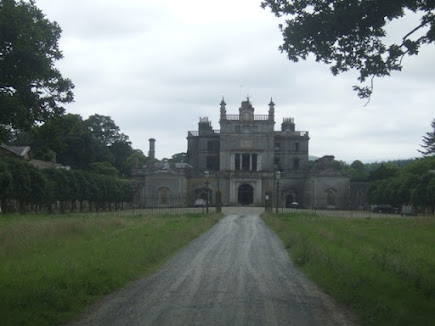 |
| Back of Curraghmore House / John M / CC BY-SA 2.0 |
The Irish Beresfords are a family of great antiquity, descended from Sir Marcus Beresford, who married Katherine, Baroness de la Poer, sole heiress of de la Power and Curraghmore. Among their family portraits is one of a certain Lady Beresford, clad in the picturesque dress of the latter part of the seventeenth century, and wearing round her right wrist a broad band of black ribbon.
 |
| Lady Beresford |
Thereby hangs the following story:
In the month of October, 1693, Sir Tristram and Lady Beresford were the guests of Lady Macgill, at Gill Hall, the present seat of Lord Clanwilliam.
One morning Sir Tristram awoke early and went out for a long walk before breakfast, leaving Lady Beresford still asleep in bed.
On his return the family sat down to breakfast. Lady Beresford was still absent, and as the meal progressed Sir Tristram became anxious, and a servant was sent in search of her. Presently she entered the dining-room, showing plainly by her looks and manner that something serious had happened.
Sir Tristram inquired the cause of her agitation, and then, noticing that she was wearing a broad piece of ribbon bound tightly round her right wrist, he asked anxiously whether she had met with an accident.
 |
| The Black Ribbon |
Lady Beresford begged him in an undertone not to make any remarks about the ribbon, adding in a vehement whisper, "You will never see me without it again."
"Very well," said Sir Tristram, "since it is a secret then I will make no more inquiries about it."
Lady Beresford then asked whether any letters had arrived for her, and Sir Tristram asked her if she had any particular reason for so doing.
"Yes," she replied, "it is because I am expecting to hear of the death of Lord Tyrone, which took place on Tuesday last."
As Lord Tyrone, who was a family friend, was then supposed to be in his usual health, Sir Tristram at once concluded that his lady had had a bad dream, which had evidently preyed upon her mind. At that moment, however, a letter with a black seal was handed to Sir Tristram, and the moment Lady Beresford saw it she exclaimed, "It is to say he is dead!"
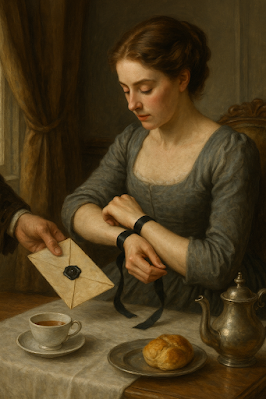 |
| A Letter With a Black Seal |
The letter, which was from Lord Tyrone's steward, was indeed found to contain the sad news of his lordship's death. Lady Beresford, although greatly grieved, declared she felt almost relieved, for now she knew the worst. She then informed her husband that the child that was soon to be born to her would be a boy, a fact of which she said she felt quite as certain as she had done respecting the news about Lord Tyrone.
In the following July a son was born, and about six years afterwards Sir Tristram Beresford died. Lady Beresford then withdrew herself from society, and taking her two children with her, retired to one of the family seats in County Derry, where she proceeded to lead a simple country life of secluded calm.
Among her neighbours were some connections of the family, a Mr. and Mrs. Jackson, who had a house at Coleraine. Mrs. Jackson had been formerly a Miss Gorges, daughter of Dr. Robert Gorges, and her brother, Richard Gorges, often stayed with her. While on one of these visits to his sister he promptly fell in love with the still young and comely Lady Beresford, and in 1704 they were married.
The marriage turned out an exceedingly unhappy one. Two sons and a daughter were born to the ill-assorted couple, but soon after the birth of the second son they parted. Through all these years Lady Beresford still wore the band of black ribbon round her wrist, and no eye ever beheld her without it.
When Sir Marcus Beresford, her eldest son, was a lad of about twenty, his mother invited him and also her daughter, Lady Riverstone, to be present at some celebrations in honour of her birthday. Dr. King, the Archbishop of Dublin, and an old clergyman who had christened Lady Beresford were also present. The latter was specially honoured by his hostess, and in the course of conversation she said to him:
"You know I am forty-eight to-day."
"Nay," he replied, "I can assure your ladyship that you are only forty-seven."
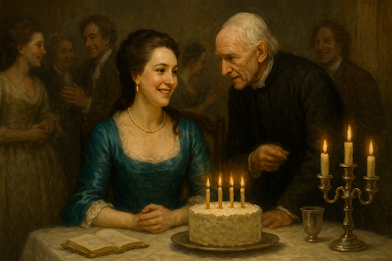 |
| A Birthday Celebration |
"Then," said Lady Beresford, "you have signed my death-warrant. Send my son and daughter to me immediately, for I have much to do before I prepare for death."
When alone with her two children Lady Beresford told them that she had something of great importance to communicate to them, and forthwith proceeded to disclose the mystery of the black ribbon by relating the following weird story.
She and Lord Tyrone, she said, had been educated together as children, and the greatest sympathy and love ever existed between them. They were both brought up as Deists, but had strong leanings towards Christianity, and being greatly doubtful and perplexed, they made a solemn promise that whichever died first would, if permitted, appear to the other to declare which religion was more acceptable to God.
 |
| A Solemn Promise |
One night, she went on, as she was sleeping in her bed at Gill Hall, she suddenly awoke and saw Lord Tyrone standing by her bedside. Terribly frightened, she was about to scream and awaken her husband, but at last she found courage to address him. "Tell me, why are you here at this hour of the night?"
"Have you forgotten our compact, pledged to one another years ago?" he replied. "I am allowed thus to appear to tell you that the Christian religion is the one by which you will be saved."
The ghost then informed her that she would be blessed with a long-wished-for son, that she would survive her husband and marry a second time, and that she would die at the age of forty-seven. "I myself," he added, "died on Tuesday at four o'clock."
Lady Beresford then begged the apparition to give her some sign so that in the morning she might know the whole episode had not been a dream. "Reach out your hand," said the spirit. Lady Beresford did so, whereupon he laid his hand, which was cold, like marble, heavily upon her wrist. Immediately, the nerves withered and the sinews shrank, leaving a broad red scar.
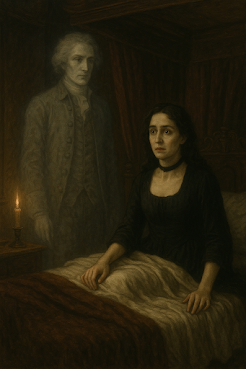 |
| The Ghost of Lord Tyrone |
Next morning Lady Beresford bound her wrist with black ribbon, and as time went on all the prophecies were fulfilled in a most remarkable manner except, apparently, that of her death, for she was congratulating herself that she had passed her fatal forty-seventh birthday, when the old clergyman disillusioned her by informing her that she was really only forty-seven at present.
Lady Beresford added that she wished her son and daughter to untie the piece of black ribbon after she was dead. They left her quite calm and about to sleep, but an hour later her bell rang hastily, and all was over. Before she was put in her coffin, however, Sir Marcus Beresford and Lady Riverstone knelt solemnly by her bedside and removed the black ribbon as they had promised. They found the wrist marked and scarred exactly as their mother had described.
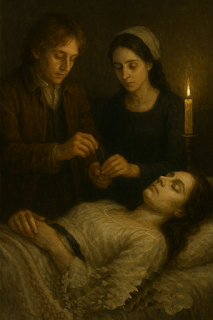 |
| Removing the Ribbon |
The renowned true ghost story trilogy is back in print: The Grey Ghost Book, Another Grey Ghost Book, and The White Ghost Book
This BookBrains Illustrated and Annotated Edition features:
- Over 120 illustrations that breathe new life into these chilling tales.
- Nearly 800 annotations to help readers with early 20th-century references they may be unfamiliar with.
- An introduction to the work that places it in historical context.
- A biographical sketch of the author and her career.
The Grey Ghost Book (1912) by Jessie Adelaide Middleton is a pioneering work of supernatural investigation that documents authentic accounts of ghostly phenomena with journalistic integrity. Unlike fictional ghost stories of its time, Middleton's collection represents a serious attempt to validate real spectral encounters reported by credible witnesses across various social backgrounds.
Get The Grey Ghost Book at Amazon.
In the Next Post:
We'll share a "true" ghost story from Another Grey Ghost Book by Jessie A. Middleton.



Comments
Post a Comment